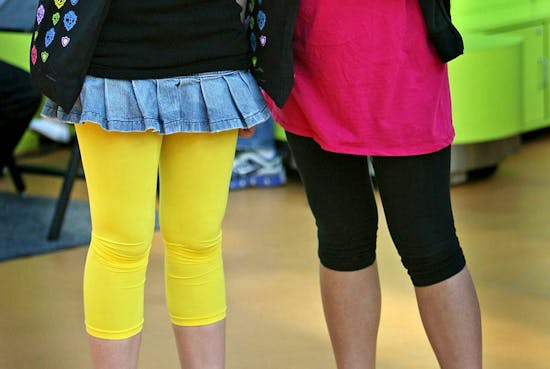Dozens of parents and high schools across the metro endorsed a Minnetonka principal's message Tuesday that discourages teen girls from wearing trendy tight-fitting leggings with increasingly shorter tops.
Sparking the latest debate over what's appropriate attire in schools, David Adney sent an e-mail to high school parents Monday asking them to talk to their daughters about wearing spandex-like yoga pants or other tight-fitting leggings with T-shirts that expose "more leg and backside" and can "be highly distracting for other students."
From Forest Lake to St. Paul, more than 70 parents and other high schools called or e-mailed Adney supporting his message, which didn't ban leggings, but urges teens to dress more modestly.
"It must have touched a nerve," he said, saying the school tries to get ahead of problem trends.
It's certainly not the first time fashion and high school policies have clashed. In past years, schools have had to deal with spaghetti straps, exposed midriffs and sagging pants. Minnetonka last year cracked down on boys wearing muscle shirts.
"It's not about trying to be the clothing police, it's just a sensitivity issue," Adney said. "Hopefully with us being the first to speak up, it will create a lot of conversations."
'Way out of control'
The e-mail sparked a discussion in the Colwell household in Chanhassen.
After Traci Colwell saw it, she sat down with her 14-year-old daughter to talk about how to appropriately wear yoga pants to school.
"I said, 'See, I'm not the only one to feel this way,'" she said. "It's gotten way out of control the way kids dress."
Like a lot of girls, freshman Carine Colwell wears yoga pants to school two to three times a week because they're comfortable. But some classmates are taking the trend a step further, she said, wearing see-through nylon tights as leggings. Still, the principal's warning upset a lot of students at school Tuesday, she said.
"Some kids were really mad because they're comfortable," she said. "As long as they're not see-through, they should be allowed."
Her mother added that it will be a challenge for the school to enforce.
"It's a tough situation to deal with because that's what the stores are selling, it's in magazines ... that's what kids are wearing and adults are wearing," she said. "You see it all over."
In the past month, Adney said he's received about a half-dozen complaints from female staff, school volunteers and female students concerned about girls wearing spandex and other tight leggings. In the past, girls wore the leggings with long sweat shirts or jerseys, he said, but the trend of wearing them now with shorter shirts leaves their backside too closely defined.
"This new trend doesn't seem right, it's troubling," he said. "Cover your butts up -- I'm just going to say it straight up. We're seeing too much."
Christine Helgeson, whose son attends the high school, was glad to see Adney address it before the fashion trends trickle down to younger kids.
"They're setting an example for our middle school kids," she said.
Legality of dress code
Principals say concerns about fashion trends come up nearly every year -- for boys and girls alike.
In Richfield, high school Principal Jason Wenschlag said they've had issues this year with girls wearing trendy knit hats, and the school is trying to decide how to enforce against it since boys aren't allowed to wear baseball hats.
"It's a constant battle," he said about keeping on top of what's appropriate.
Minnetonka teachers have also had to enforce a no-hat policy among boys this fall, Adney said, following last spring's trend of boys wearing muscle shirts that were too revealing. Before that, it was boys wearing sagging pants.
A decade ago when he first started as principal, the culprits were low-cut jeans and low-cut one-shoulder shirts on girls.
Minnetonka's handbook says attire can't disrupt education, be offensive or inappropriate.
Don Johnson, executive director of the Minnesota Association of Secondary School Principals, said schools are legally allowed to list clothing restrictions in handbooks, which are approved by school boards.
"Students will always look for something that will be trendy; if it's disruptive to the educational process, it may be banned," Johnson said.
Minnetonka High School is often the lightning rod, he said. "It's a large high school and with fairly well-to-do students who can afford the latest fashion, and they have high expectations for education."
Kelly Smith • 612-673-4141 Twitter: @kellystrib





